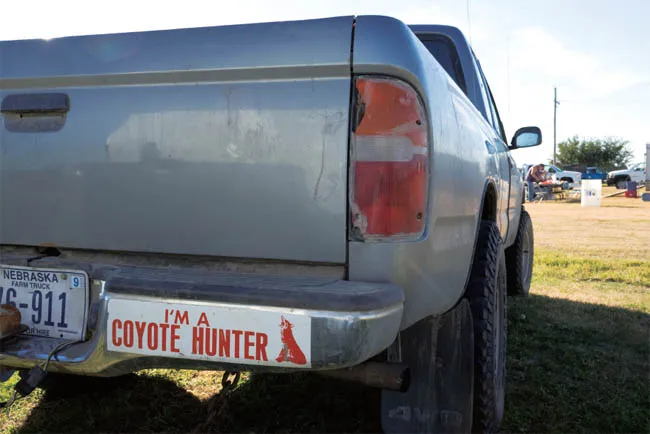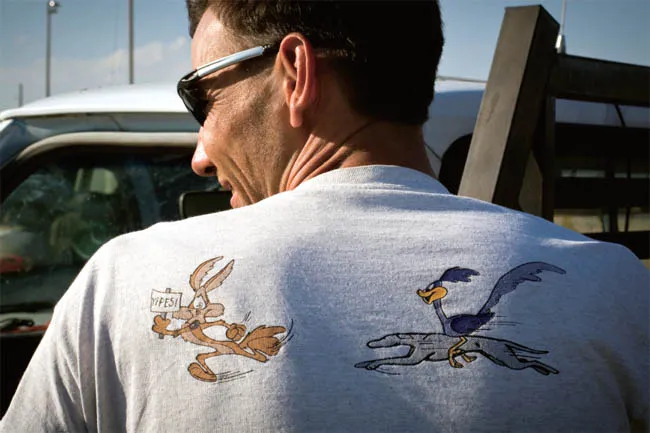![]()
Loomis Trade-N-Days
The stretched afternoon shadow from a massive row of grain elevators points past a one-bleacher high school football stadium to an open grass field where they will watch them run. Coyote hunters from Canada to Texas and from Ohio to California gather in Loomis, Nebraska, to trade and race their dogs the first weekend of every October. They are not here to hunt coyotes; it is still too hot. But knowledge about coyote coursing is never so concentrated and discussion of it never so thick as at Loomis’s Trade-N-Days.6
Trucks and trailers self-assemble in informal rows, leaving a wide swath of grass for tomorrow’s races. In the shade of their rigs, dogs rest, staked wide apart for potential buyers’ easy viewing. Hunters check out vendors selling custom collars and discount dog food. They bump into old friends and make new ones. Little groups form around an open tailgate, a cooler of beer, or a particularly fine-looking hound. Individuals drift from group to group. Clusters suddenly dissipate as new ones spontaneously emerge. Conversations begin easily and laughter comes quickly as everyone here has something they love in common.
For two days, hundreds of coyote-coursing tradition bearers gather to exchange information on, and improve the ways of, their sport. The following vignettes focus on a few of them. Letting practitioners speak for themselves reveals what traditional aesthetic and environmental knowledge is at play in the sport. It also manifests the tradition’s form, function, and significance to these people of the plains.
The Johnston Place
Raye Johnston breeds greyhounds and organizes the Loomis Trade-N-Days event. Fine, alert-looking dogs pace their runs at his place, down a long gravel road and past a short turn-off through the mud. While transferring some dogs between pens that also hold donkeys, Raye shares hopes and concerns about breeding, the coming season, and the animal rights threat.
“The mange has been terrible around here, but a good freeze will kill it off. We had a good front this year and some good ice. So here’s hopin’. Years back we had twenty-eight days without power and icicles drooping eight feet off the power lines. That’s what the old timers say. I bet they caught a lot of coyotes that year.
“We aren’t interested in anything like breed standards here, only performance. In the past we’ve liked to cross in some Irish wolfhound or borzoi. But lately, we have had a heck of a time finding one worth crossing with. These dog fancy people have bred their brains out—lots of defects and genetic problems. Bred to stand still while judges poke them, not to hunt. They are wrecks.7 A saluki cross might get you a nice up dog. But it won’t kill. The Arabs bred them to rabbits. And a rabbit is not a coyote.
Collars for sale by a Trade-N-Days vendor.
Round bales on the Nebraska Sand Hills.
“If animal rights folks have come here, I haven’t seen them. They don’t need to. We take care of our dogs and take care of the event. Once this fellow got drunk on Friday night and let his dogs fight in their box. He took them out on Saturday to sell all cut and bloodied. I told him to pack up and take his dogs home and don’t come around here. I don’t worry about PETA too much, but I think this might be on people’s mind’s a little more since you fellas are here asking questions and they wonder who you are but . . . Hey! Help me get those donkey’s back in the pen!”
Raye’s cousin Butch and Jeremy—a friend and fellow hunter down from Alberta—help herd Raye’s escaped donkeys back into their pen and then turn back to talking dogs. Jeremy says, “My uncle was never much interested in my dogs. But then deer started coming through his fields and the bucks would jump up and piss on his round bails all the time. Totally ruined them. The cattle wouldn’t eat them. So he calls me up and wants me to bring my dogs over so he could tie them up and let them loose when the deer came by.”
Butch adds, “You know, they really ought to allow deer coursing. We are so overrun and they do so much damage. Deer are not so game as a coyote though. Deer have no heart. They go right down as soon as the dogs touch them. Not that I know anything about that! Not that I have done it. That’s illegal. But I have seen it happen . . . on accident.”
Jeremy says, “You know, what we are overrun with is turkeys. I see them everywhere. Once I had to stop the truck for ten minutes while hundreds of them moving in a herd crossed the street. And guys come here from the city and pay guides to find turkeys. I don’t get it.”
Butch says, “Yeah, you’ll see guys come in here with outfitters and they got their Mossy Oak cammo and their high-dollar bird calls. I don’t know why they go to all this trouble when you can just shoot them from the truck. I’ll tell you what, a turkey’s got a brain the size of your thumb and they are dumb as rocks and these guys are spending all this money to outsmart a turkey. It doesn’t bode well for the human race.
“I think there’ll be a lot of people at Loomis this year since they haven’t had rain last month in Kansas. They won’t be so into harvest yet. They can break free for a couple of days; but if they are full into it, they won’t come.
“Coyotes are magnificent animals. They control mice and rats and coons. I love ’em. I’m the last one who wants to see them gone. But who will watch out for them if we hunters disappear?”
Matt
Sitting in his new truck at the Trade-N-Days site, Matt Stoddard tells a story about his old one. “I don’t know why we spend such big money on high-dollar trucks when you know what we do to them. Once I was following the dogs chasing coyotes through a field and the prairie grass had grown up and hidden a big rut. Well, I drove right into it going 50, maybe 70. Bent my frame into a total V. I smashed my nose onto the steering wheel; blood’s spurting everywhere and big chucks of cartilage are sticking out. I’m holding it all in with my hand, looking all around, ‘Where are the dogs? Where’s the coyote? There they are! Don’t lose them. Can we still drive it? It’ll drive! Let’s go!’ That business cost me a lot of money for a new truck and a new nose. But it was worth it to watch ’em run. Everything focuses in on the chase.
“If you want to get into this, your first coyote will cost you $4,000, but it gets cheaper after that. You got to love it or you’ll burn out in a heartbeat. I love it. See those dogs? That’s Hammer Time. He’s triple bred from John Wier’s “H.” H was a pretty famous dog around here. Talk to anyone; they’ll know about him. Often with dog names we’ll keep the first letter or a whole part of the name from the sire. H sired Hammer, who sired Hammer Time right there. I’d sure like to see your book when you’re done, but don’t take pictures of the kill. That’ll ruin it for everybody.”
Larry
Tall and tanned Larry Stoddard, Matt’s dad, chats with a small group gathered around a husband and wife in their Toyota Tundra coyote rig: “I loved that dog. Somebody offered me way too much money for her once and I let her go.”
“Are you sorry you did?” asks the man in the Tundra.
Larry thinks a moment, “In a way I am. In a way I’m not. I’m sad she’s gone, but maybe my marriage will last another year.”
The group laughs, encouraging another story from Larry.
“A lot of the stories people tell about dogs around here remind me of this joke I heard. There were these two Jewish ladies having lunch together, and Hannah says to Judy, ‘Why, that’s a lovely ring you’re wearing Judy; look at those diamonds!’
‘Oh, yes, my husband gave it to me.’
‘But I notice you’re wearing it on your right hand, so its not your wedding ring,’ says Hannah.
‘That’s right, he gave it to me when our first son was born.’
Hannah says, ‘That’s nice. Did he give you anything for your other kids?’
‘Yes he gave me this gold necklace when my second child was born.’
Hannah says, ‘That’s nice.’
‘And that Lexus outside we drove here in—he gave it to me when our third child was born.’
Hannah says, ‘That’s nice.’
Judy asks, ‘So, Hannah, did your husband ever do anything like that for you?’
Larry Stoddard at Trade-N-Days.
‘Oh sure! When my first child was born my husband paid to send me to school to learn how to talk properly to people.’
Judy asks, ‘What do you mean?’
‘Well, I used to say, “bullshit!” ’ says Hannah.
‘And what do you say now?’ asks Judy.
Hannah says, ‘I say, “That’s nice.’ ”
When the laughter subsides, Larry, noticing the Tundra’s “She-and-I Greyhounds” window sticker, asks the woman sitting shotgun, “So you must be the “she” of “She-and-I.”
“Sure,” she says, “when it comes to all the work of feeding and cleaning, but when it comes to deciding who gets bred with whom—you know, the important stuff—he does all that. He waits until I’m gone at work and then goes out and makes all the decisions.”
Her husband turns to her and says, “That’s nice.”
Photo from Leon V. Almirall’s 1926 Coyote Coursing.
Ted
One hunter spots Scott’s camera and suspects animal rights activists infiltrating the gathering to make an exposé. Ted asks, “So, are you going to take pictures of a coyote eating the ass off of a calf as it’s getting born, chewing it right into the cow? And the rest of the pack is eating her teats, and all this is happening because there are no dogs around to protect them? I’ve seen that, but I bet it won’t be in your book with pictures of dogs tearing coyotes. What we do is no different; no, it’s better than what coyote packs do to each other when protecting their territory and get a hold of an outside coyote trying to intrude.”
Ted is acutely aware that to see pictures of dogs killing coyotes would be provocative for many people. He wisely knows the power of images and wants potential readers to know that other, even more horrifying, things happen to animals when coyote populations are not managed. He articulates that there is a wholesomeness—even a necessity—in a pra...







